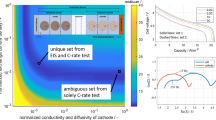Abstract
In lithium battery research, when we need to establish equivalent circuit based on impedance measurement, we can find several suitable circuit models. We usually use the chi-squared to determine the validity of equivalent models; when the chi-squared is less than 0.01, it indicates that those models have good fitting effect. In this case, we propose to verify the Kramers–Kronig transformation by extrapolating the data with equivalent circuit model and compare the residual errors of the Kramers–Kronig transform to determine the most suitable equivalent circuit model.





Similar content being viewed by others
References
Kramers, HA, (1927) La diffusion de la lumiere par les atomes. In: Atti Cong Intern Fisica (Transactions of Volta Centenary Congress) Como; J Electrochem Soc 554-557
Kronig, RDL (1926). On the theory of dispersion of X-RAYS. J Electrochem Soc. 12(6):547–540
Macdonald DD, Urquidi MM (1985) Application of Kramers-Kronig transforms in the analysis of electrochemical systems: I. Polarization resistance 132(10):2316
Macdonald M, Real S, Macdonald DD (1986) Application of Kramers-Kronig transforms in the analysis of electrochemical impedance data: II. Transformations in the complex plane 133(10):2018
Boukamp B (1993) Practical application of the Kramers-Kronig transformation on impedance measurements in solid state electrochemistry. Solid State Ionics 62(1–2):131–141
Bruzzoni P, Carranza RM, Lacoste JC, Crespo EA (2002) Kramers–Kronig transforms calculation with a fast convolution algorithm. Electrochim. Acta. 48(4):341–347
King F (2002) Efficient numerical approach to the evaluation of Kramers-Kronig transforms. Electrochim Acta 19(10):2427–2436
Haili CC (1987) The corrosion of iron rotating hemispheres in 1 M sulfuric acid: an electrochemical impedance study. 1987
Cruz-Manzo S, Chen R, Greenwood P (2015) Evaluate the validity of electrochemical impedance measurements of polymer electrolyte fuel cells using a computational algorithm based on Fast Fourier Transform 1(1):3
Chalashkanov NM, Dodd SJ, Fothergill JC (2012) Limitations of kramers-kronig transform for calculation of the DC conductance magnitude from dielectric measurements. In: 2012 Annual Report Conference on Electrical Insulation and Dielectric Phenomena. 251–254
Zhang Z, Huang Y, Jin C, Sun P (2017) Calculation of integral singularities in Kramers-Kronig relations. 53(3):272–275
Ren P, Pei P, Li Y, Wu Z, Chen D, Huang S, et al (2019) Diagnosis of water failures in proton exchange membrane fuel cell with zero-phase ohmic resistance and fixed-low-frequency impedance. Applied Energy 239(APR.1):785–79
Fasmin FS, R. (2015) Detection of nonlinearities in electrochemical impedance spectra by Kramers-Kronig transforms. J Solid State Electrochem 19:1833–1847
Haghnegahdar N, Abbasi TM Dastan D (2021) Curcumin-functionalized nanocomposite AgNPs/SDS/MWCNTs for electrocatalytic simultaneous determination of dopamine, uric acid, and guanine in co-existence of ascorbic acid by glassy carbon electrode. J Mater Sci: Mater Electron. 32:5602–5613
Ke SA, Fz A, Zzy A et al (2020) Mixed conductivity and the conduction mechanism of the orthorhombic CaZrO 3 based materials. Surfaces and Interfaces
Funding
This work was supported by the Fund Project of the GDAS Special Project of Science and Technology Development, Guangdong Academy of Sciences Program (No. 2020GDASYL-20200104030); the Innovation Project of Guangxi University of Science and Technology Graduate Education (YCSW2020217); Guangxi Innovation Driven Development Project (No. AA18242036-2); Innovation Team Project of GuangXi University of Science and Technology (No.3), and the Fund Project of the Key Lab of Guangdong for Modern Surface Engineering Technology (No. 2018KFKT01).
Author information
Authors and Affiliations
Corresponding author
Additional information
Publisher's Note
Springer Nature remains neutral with regard to jurisdictional claims in published maps and institutional affiliations.
Rights and permissions
About this article
Cite this article
Luo, J., Liang, X., Zhang, Y. et al. Application of the Kramers–Kronig relationships in the electrochemical impedance models fit. J Solid State Electrochem 25, 2225–2233 (2021). https://doi.org/10.1007/s10008-021-04975-1
Received:
Revised:
Accepted:
Published:
Issue Date:
DOI: https://doi.org/10.1007/s10008-021-04975-1




